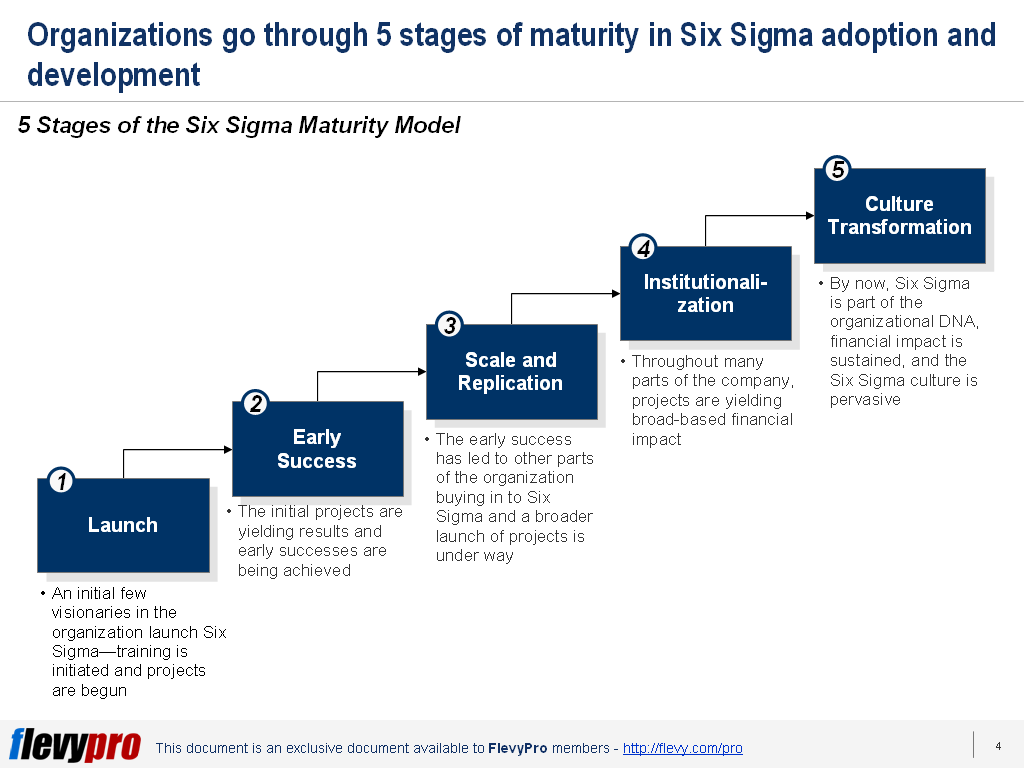Is it difficult to deploy Six Sigma?
As the case with all management models, the theory may come easily, but execution can be tough. The same goes with Six Sigma. To assist with Six Sigma deployment, follow the Six Sigma Maturity Model. The Six Sigma Maturity Model provides a structured, phased approach to implementing Six Sigma over five logical stages. This methodology helps Six Sigma practitioners, deployment leaders, and executives achieve the following objectives:
- Benchmark where their companies stand about broader patterns experienced by other organizations
- Assess the areas of strength and performance gaps in their deployments
- Pinpoint specific steps they might take to close gaps and graduate to the next stage of their Six Sigma journey
- Communicate progress to their Six Sigma teams and to the broader community within their companies to garner support for their continuous improvement efforts
The five stages of maturity in Six Sigma adoption and development are as follows:
- Launch. In the early onset, there are only a few visionaries in the organization who decide to launch Six Sigma. The focus is on training and launching a few initial projects.
- Early success. By the second stage, the initial projects are yielding results and early successes are being achieved.
- Scale and replication. The early success has led to other parts of the organization buying into Six Sigma and a broader launch of projects is underway.
- Institutionalization. By now, throughout the organization, projects are yielding broad-based financial impact. People are seeing, understanding, and realizing the value of Six Sigma.
- Lean culture transformation. By this final stage of maturity, Six Sigma is part of the organizational DNA, financial impact is sustained, and the Six Sigma culture is pervasive.
Now, let’s take a slightly deeper dive into these stages.
Launch
Six Sigma is launched within an enterprise. The launch usually occurs with the help of an external consulting and training firm. Consultants typically preside over initial executive and champion sessions designed to establish the potential impacts of Six Sigma on business operations, revenues, costs, and the company culture.
There is buy-in to start the initial training sessions to get a core group of Black Belts and Master Black Belts who will lead the initial projects. Organizations generally appoint a vice president or director of Six Sigma who reports to an executive sponsor and whose charter is to ensure a successful deployment of Six Sigma.
The launch stage typically lasts from three to nine months.
Early success
At this level, the initial projects are well underway and many have been completed. Improvements have already demonstrated significant financial and other impacts. The support that was given to the initial team is being validated by the early results.
The key difficulty is to ensure these initial projects are completed in a reasonable time and that they have a meaningful financial impact on the business. Typically, companies stay at this level between 6 and 18 months.
Scale and replication
At this level, the company has experienced solid success from the initial deployment, and other parts of the company are buying into Six Sigma. This is the stage where the Six Sigma effort scales across the company and gathers momentum. Many waves of training are in progress across many parts of the company. Projects are being pursued in multiple organizations (divisions, plants, units, etc.).
Organizations stay at this stage typically from one to three years.
Institutionalization
At this stage, it is not just replication of the success of another organization, but replication of the success within each organization in the company. There is enough financial impact from projects in each organization that meaningful comparisons can be made between organizations on average project impact, average cycle time, total impact, etc.
The Six Sigma processes have become institutionalized throughout the company. This stage can last two to four years, if not longer.
Lean culture transformation
At this level, the company has had sustained success with Six Sigma for a long period. Six Sigma is embedded in the company DNA. The methodologies of Six Sigma are applied not just to Six Sigma projects and by people trained in Six Sigma, but throughout all execution processes.
Six Sigma also has been applied to the “extended enterprise”– customers, vendors, distribution chain, and supply chain – for mutual benefit across all collaborations and partnerships. The culture is data-driven, process- and metrics-oriented and focused on financial impact.


In my personal opinión, the success or failure of a 6 Sigma process (or any other project) lay down in ownership. If you have success in making the personnel to own the project as theirs, your project will be successful and will last beyond the initial stage.